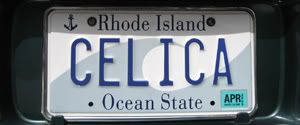  |
 Aug 8, 2005 - 11:25 AM Aug 8, 2005 - 11:25 AM
|
|
|
Moderator      Joined Oct 1, '02 From fall river, ma Currently Offline Reputation: 13 (100%) |
here is some info that i think we could use here that i took from rickyb on the mr2 board about diffrent dynos:
As a tuner I often spend at least ten minutes explaining the different types of dynos and their application to my cutomers. Modern chassis dynamometers come in basically two flavors: intertial or braking. The Dynojet 248C is the current workhorse of the automotive chassis dyno industry and it is a pure intertial dyno. The power output of the engine is measured by determining how quickly the car can spin up a large rotating drum. The advantages of this setup are low cost and highly repeatable and accurate results even across different dynos. That means that you can take your car to any 248C across the country and at the same general elevation you should get very similar results. This is why discussion boards dismiss any dyno results except those produced on these dynos as being comparable to any other results. The downside of these dynos is that torque can only be measured as an effect of acceleration of the drum. This is a problem because both engines and drums have a maximum safety limit on how fast they can rotate before they can self-destruct or pose very potential safety issues. As a result, inertial dynos are good primarily for testing WOT power. Brake dynos are a different beast. These dynos use a braking system of some sort and a device to measure actual instantaneous torque. The adjustable braking force is provided by either a water brake (basically a very inefficient water pump that turns engine output into instant hot water) or eddy current (a short-circuted electric generator that turns engine output into hot air). Many manufacturers make these including Mustang Dyno, Dynapack, Dyno Dynamics and Dynojet. Because these dynos can provide a predetermined amount of braking force equal to or just slightly greater or lower than engine output, they can be used to hold an engine at many different RPM and load points. This makes them ideal dynos for tuning not just at WOT but at many different load points. The downside of these dynos is that their torque measuring devices need to be calibrated regularly (not a difficult process) to keep them accurate across dynos and even on the same dyno over different periods of time. Most brake dynos have practically zero inertial component, which makes it easy to reach a given RPM set point quickly. On these dynos you can take off in any gear. There are advantages to this in terms of being able to reach high RPM and load points quickly even on fairly wimpy engines. Some dynos such as the new Dynojet 224xLC have both an inertial and a braking component. The advantage to this is that they can more easily reach the low load, high RPM points that your engine can be in while you cruise on the highway. A good tuner can more easily and quickly reach and precisely tune more of your EMS map with one of these dynos. Like with most everything else, all modern chassis dynos are good at what they were designed to do and sometimes can be passably used to do things that they weren't designed to do. If you plan to use a dyno, be very clear and specific in your mind about what you want to use it for before you decide on which one to use. If you want to publish results that you can brag about on this board, you will most likely want a Dynojet 248C. If you want to tune your EMS, you will be able to do that more precisely on a load holding dyno. In most cases, unless you are tuning the EMS yourself, it is best to choose the tuner and go with whatever he can do the best job with. If that is not a 248C, then you can always go find one of those after the car is properly tuned to find out how your car compares against some of the results posted on the public forums. -------------------- Former Team 5SFTE pro member ;)
 13.6@108MPH, 5SFTE Powered |
 Aug 9, 2005 - 12:11 AM Aug 9, 2005 - 12:11 AM
|
|
 Enthusiast      Joined Mar 8, '04 From Newport, RI Currently Offline Reputation: 63 (99%) |
interseting...but I don't think too many members are going to dyno their 93 or 114 whp celis...
I hope this post doesn't get lost in space... -------------------- |
 Aug 9, 2005 - 9:19 AM Aug 9, 2005 - 9:19 AM
|
|
|
Moderator      Joined Oct 1, '02 From fall river, ma Currently Offline Reputation: 13 (100%) |
ohh you konw it will, dustin...lmao.
just posted it for search purposes more than anything.. -------------------- Former Team 5SFTE pro member ;)
 13.6@108MPH, 5SFTE Powered |
 Aug 9, 2005 - 9:45 AM Aug 9, 2005 - 9:45 AM
|
|
 Enthusiast      Joined Nov 4, '02 From Hecho en la Republica Dominicana/Living in NJ Currently Offline Reputation: 0 (0%) |
nice post manny ... which was the dyno you used ?
-------------------- |
 Aug 9, 2005 - 10:55 AM Aug 9, 2005 - 10:55 AM
|
|
|
Moderator      Joined Oct 1, '02 From fall river, ma Currently Offline Reputation: 13 (100%) |
dynojet 248c, mac
-------------------- Former Team 5SFTE pro member ;)
 13.6@108MPH, 5SFTE Powered |
 Aug 9, 2005 - 11:40 AM Aug 9, 2005 - 11:40 AM
|
|
 Enthusiast      Joined Feb 10, '03 From Connecticut Currently Offline Reputation: 11 (100%) |
The place I was going to dyno at has a Mustang dyno...which doesnt seem all to great anymore.
-------------------- |
 Aug 9, 2005 - 4:56 PM Aug 9, 2005 - 4:56 PM
|
|
|
Enthusiast      Joined Aug 31, '02 From Philadelphia, PA Currently Offline Reputation: 8 (100%) |
yeah, i wouldnt even bother going to a mustang dyno place.
-------------------- 15PSI - 30MPG - Megasquirt Tuned
|
 Aug 9, 2005 - 9:05 PM Aug 9, 2005 - 9:05 PM
|
|
|
Enthusiast      Joined Jan 17, '04 From Illinois Currently Offline Reputation: 0 (0%) |
If you have EMS and are having the car tuned on the dyno, brake dynos are the only way to go. An inertial dyno like the Dynojet have real limitations in this regard as Rick's post points out. I want my car to run smoothly which requires the tuner to hold different load points as he is tuning. This CANNOT be done on an inertial dyno. The good tuners that are stuck using an inertial dyno spend a considerable amount of time "street tuning" the car. This just means that they are holding different load points while driving the car around. Unless you have miles and miles of abandoned countryside, that is not always easy to do and is certainly more time consuming and less exacting that using a brake dyno. There are many people who call themselves tuners that don't even know this difference. Many of them just tune for WOT and interpolate the rest of the load points either through an "autotune" function or otherwise. Its the ghetto way to do it and the tune will likely fall short of its potential and could seriously risk the longevity of your engine.
This post has been edited by jgreening: Aug 10, 2005 - 9:21 AM -------------------- QUOTE(lagos @ Jul 10, 2006 - 1:55 PM) [snapback]454118[/snapback] i know your trying to do the right thing for your motor, but this is one of those times where you should just trust the guys who have had their swaps for a while and have done a ton of research into this. |
 Aug 9, 2005 - 9:15 PM Aug 9, 2005 - 9:15 PM
|
|
 Enthusiast      Joined Feb 10, '03 From Connecticut Currently Offline Reputation: 11 (100%) |
Yeah thats the thing I dont have any tuning to be done its all stock & I just want to know figures. I'll go to dynojet website to locate a dyno nearby.
Also, I see a 248X dyno on their website, but not a 248C... This post has been edited by Supersprynt: Aug 9, 2005 - 9:44 PM -------------------- |
  |
1 User(s) are reading this topic (1 Guests and 0 Anonymous Users)
0 Members:
| Lo-Fi Version | Time is now: November 24th, 2024 - 2:54 PM |






